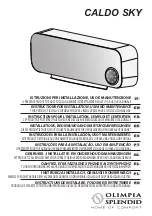
CONNECTIONS – PLUMBING
32
RELIEF VALVE DRAIN
DN20 copper drain lines must be fitted to the temperature pressure relief valve and expansion control valve (if
one is installed) to carry the discharge clear of the water heater. Connect the drain lines to the valves using
disconnection unions. The drain line from the valve to the point of discharge should be as short as possible,
have a continuous fall all the way from the water heater to the discharge outlet and have no tap, valves or
other restrictions in the pipe work.
A drain line from a relief valve must comply with the requirements of AS/NZS 3500.4.
A drain line must be no longer than 9 metres with no more than three bends greater than 45° before discharging
at an outlet or air break. The maximum length of 9 metres for a drain line is reduced by 1 metre for each
additional bend required of greater than 45°, up to a maximum of three additional bends. Where the distance
to the point of final discharge exceeds this length, the drain line can discharge into a tundish.
Subject to local regulatory authority approval, the drain lines from the temperature pressure relief valve and
expansion control valve from an individual water heater may be interconnected.
The outlet of a drain line must be in such a position that flow out of the pipe can be easily seen, but arranged
so discharge will not cause injury, damage or nuisance. The termination point of a drain line must comply with
the requirements of AS/NZS 3500.4. Drain lines must not discharge into a safe tray.
In locations where water pipes are prone to freezing, drain lines must be insulated, must not exceed 300 mm
in length and are to discharge into a tundish through an air gap of between 75 mm and 150 mm.
If a drain line discharges into a tundish, the drain line from the tundish must be not less than DN25. The drain
line from a tundish must meet the same requirements as for a drain line from a relief valve.
For multiple installations the drain line from each water heater can discharge into a common tundish (refer to
Warning:
As the function of the temperature pressure relief valve on this water heater is to discharge high
temperature water under certain conditions, it is strongly recommended the pipe work downstream of the relief
valve be capable of carrying water exceeding 93°C. Failure to observe this precaution may result in damage
to pipe work and property.
GAS INLET
The gas connection is made to the left hand side of the gas control. The pipe work must be cleared of foreign
matter before connection and purged before attempting to light the water heater. An isolation valve and
disconnection union must be used to allow servicing and removal of the water heater.
Note:
Refer to the Gas Installations Standard AS/NZS 5601.1 for the correct method of sizing the gas supply
pipe to the water heater. The pipe size selection must take into account the gas input of this water heater (
on page 29) as well as all of the other gas appliances in the premises.
Warning:
Always isolate the water heater before pressure testing the gas supply system. Disconnect the
water heater after the isolating cock to prevent the risk of serious damage to the gas control. The Everhot
warranty does not cover damage of any nature resulting from failure to observe this precaution. Refer to rating
label for gas types and pressures.
Ensure the gas line is also purged at the union of the gas control. If this procedure is not followed, a retry
lockout (i.e. single flashes on control module) may result on initial start-up.
The HSI system has a flame sensing period of 3 seconds from the time the gas valve opens. If the burner
flame is not sensed during this period, a five (5) minute waiting period follows so any unburnt gas can escape
before a second and third burner ignition is automatically attempted.
If the third attempt is also unsuccessful, the system enters the re-ignition attempt lockout mode. To reset the
water heater, press the illuminated red reset button on the lower left hand side of the water heater. If the water
heater fails to light, phone Rheem Service or their nearest Accredited Service Agent to arrange for an
inspection.
Caution:
Care is necessary when tightening fittings into the gas valve. The gas valve casting may crack if the
fittings are over tightened. Cracked valve castings are not covered under the Everhot warranty. Damaged
valves must be replaced.
















































